Speckle-interferometric Study of Close Visual Binary System HIP 11253(HD 14874) using Gaia (DR2 and EDR3)
2023-09-03HussamAljboorandAliTaani
Hussam Aljboorand Ali Taani
1 Department of Basic Scientific Sciences,Prince Hussein Bin Abdullah II Academy for Civil Protection,Al Balqa Applied University,Amman,Jordan;
2 Physics Department,Faculty of Science,Al BalqaApplied University,19117 Salt,Jordan;ali.taani@bau.edu.jo hussamaljboor@bau.edu.jo
Abstract We present a comprehensive set of physical and geometrical parameters for each of the components of the close visual binary system HIP 11253(HD 14874).We present an analysis for the binary and multiple stellar systems with the aim to obtain a match between the overall observational spectral energy distribution of the system and the spectral synthesis created from model atmospheres using Al-Wardat's method for analyzing binary and multiple stellar systems.The epoch positions are used to determine the orbital parameters and the total mass.The parameters of both components are derived as: logga=4.55,loggb=4.60,Ra=1.125 R⊙,Rb=0.88 R⊙,La=1.849 L⊙,Lb=0.342 L⊙.Our analysis shows that the spectral types of the components are F9 and K3.By combining the orbital solution with the parallax measurements of Gaia DR2 and EDR3,we estimate the individual masses using the H-R diagram as Ma=1.09 M⊙and Mb=0.59 M⊙for using Gaia DR2 parallax and Ma=1.10 M⊙and Mb=0.61 M⊙for using Gaia EDR3 parallax.Finally,the location of both system's components on the stellar evolutionary tracks is presented.
Key words: (stars:)binaries:visual–stars:kinematics and dynamics–(stars:)binaries(including multiple):close–techniques: interferometric–techniques: spectroscopic
1.Introduction
About half of the stars in the Galaxy are binaries or stellar systems (Duquennoy &Mayor 1991;Cai et al.2012).The analysis of binary systems is an efficient method for determining their physical and geometrical properties,such as the stellar masses.Close Visual Binary Stars (CVBSs) are binaries with a small separation angle(1″or less)between their components,and they are hard to detect with a small telescope.Since the long orbital periods of CVBSs have a range of 10–1000 yr,it takes a long time to observe one orbital period(Jiang et al.2013;Taani et al.2019).The visual binaries are an important source to obtain the masses and distances of the stars,which contribute to the understanding of their basic physical properties (Taani &Vallejo 2017;Taani et al.2022a,2022b).The recent measurements of such systems by the Gaia astrometry mission with increased precision have improved the distances to such systems (Collaboration 2018;Mardini et al.2019a,2019b,2020;Brown et al.2021).The system HIP 11253,being visually close enough,enables accurate measurements of its colors,color indices,and magnitude difference between its components.
In this paper,we use two methods.The first one is Al-Wardat's method for analyzing binary and multiple stellar systems(BMSSs),which was introduced by Al-Wardat(2002),and has been used to analyze many CVBSs and BMSSs (Al-Wardat &Widyan 2009;Al-Wardat 2012;Masda et al.2019;Widyan &Aljboor 2021;Al-Tawalbeh et al.2021;Al-Wardat et al.2021;Abu-Dhaim et al.2022).The main idea of Al-Wardat's method is to build entire spectral energy distributions(SEDs) of BMSSs using the model atmospheres like those of(ATLAS9) (Kurucz 1994),by implementing the available observational measurements like magnitude difference and color indices.The second method is Tokovinin's method for the dynamical analysis of binary stars(Tokovinin 1992),which was used to solve the orbit of the system.Details of this program can be found in Tokovinin (2017).
HIP 11253 is located at an R.A.of 02h20m51sand decl.of+30 °3 8′ 48″ (SIMBAD catalog).The parallax of the system is obtained from the Gaia Data Release 2 (DR2) (Collaboration 2018)with a value of 18.9878±0.627 mas,which corresponds to a distance of 52.67 pc,and the Gaia Early Data Release 3(EDR3) (Brown et al.2021) value is 18.1854±0.213 mas,which corresponds to a distance of 54.99 pc.Table 1 contains the basic information on the system from SIMBAD and other databases.

Table 1Basic Parameters and Observed Astrometric and Photometric Data of HIP 11253

Table 2Magnitude Difference between the Components of the System HIP 11253,along with the Filters used to Obtain the Observations
The aim of this study is to find reliable stellar parameters for systems that may produce the best agreement between measured magnitudes and color indices and synthetic results.In addition,we use the Gaia DR2 parallaxes(Collaboration 2018)and Gaia EDR3 parallaxes (Brown et al.2021).We emphasize that the binary system HIP 11253 is presented as an example of how to use the approach mentioned above in the case of a visual close binary with low total mass.
2.Orbital Elements
The determination of the orbital elements is crucial in calculating the stellar masses.The orbit of the HIP 11253 system is obtained using the position angles (θ) and angular separations (ρ) obtained from the Fourth Catalog of Interferometric Measurement of Binary Stars (INT4) (see Table 3),following Tokovinin's method (Tokovinin 1992).The orbit is drawn in Figure 1,and the results of the dynamical analysis and orbital solutions of HIP 11253 are listed in Table 4.
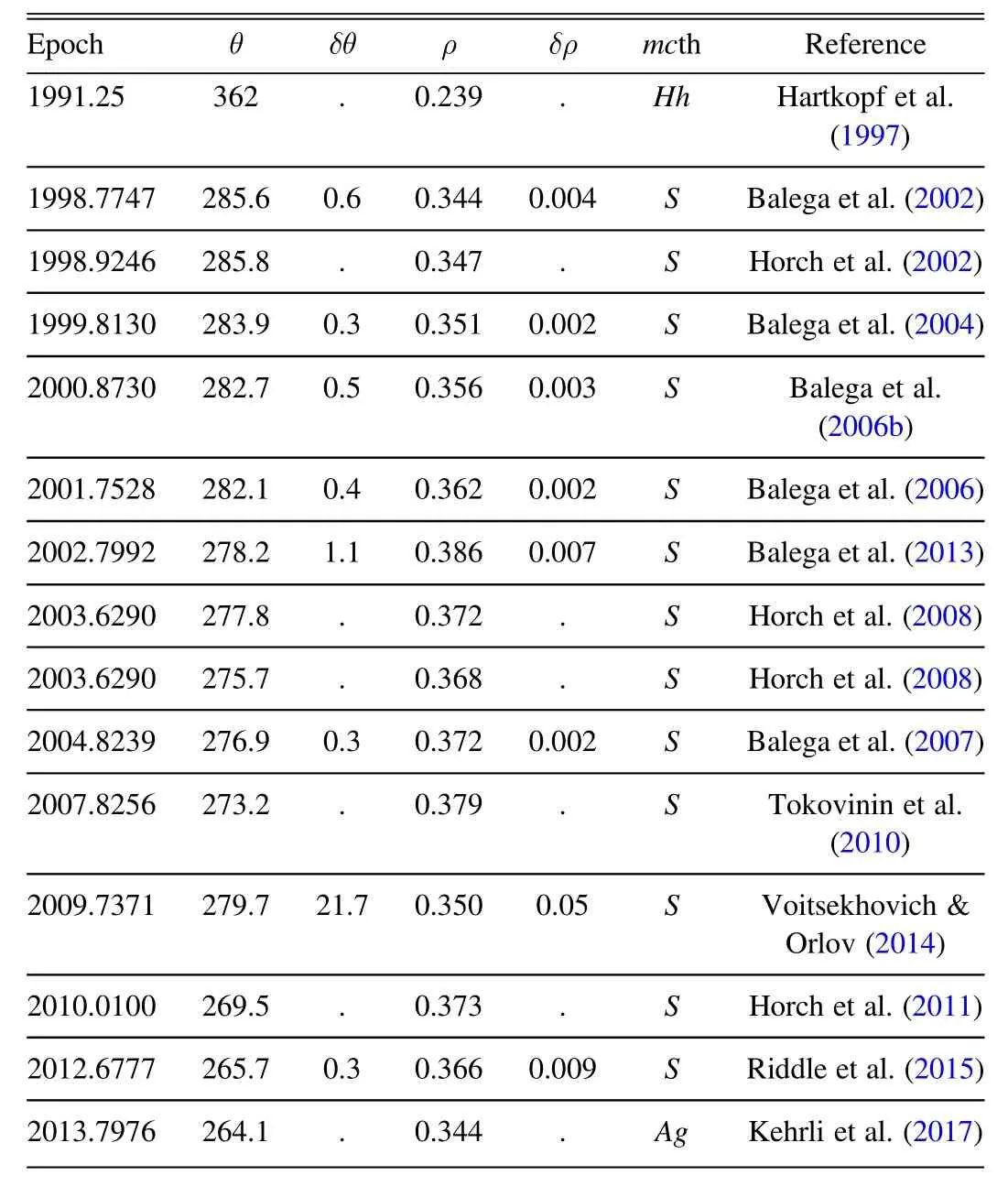
Table 3New Data on Interferometric Measurements for the HIP 11253 System
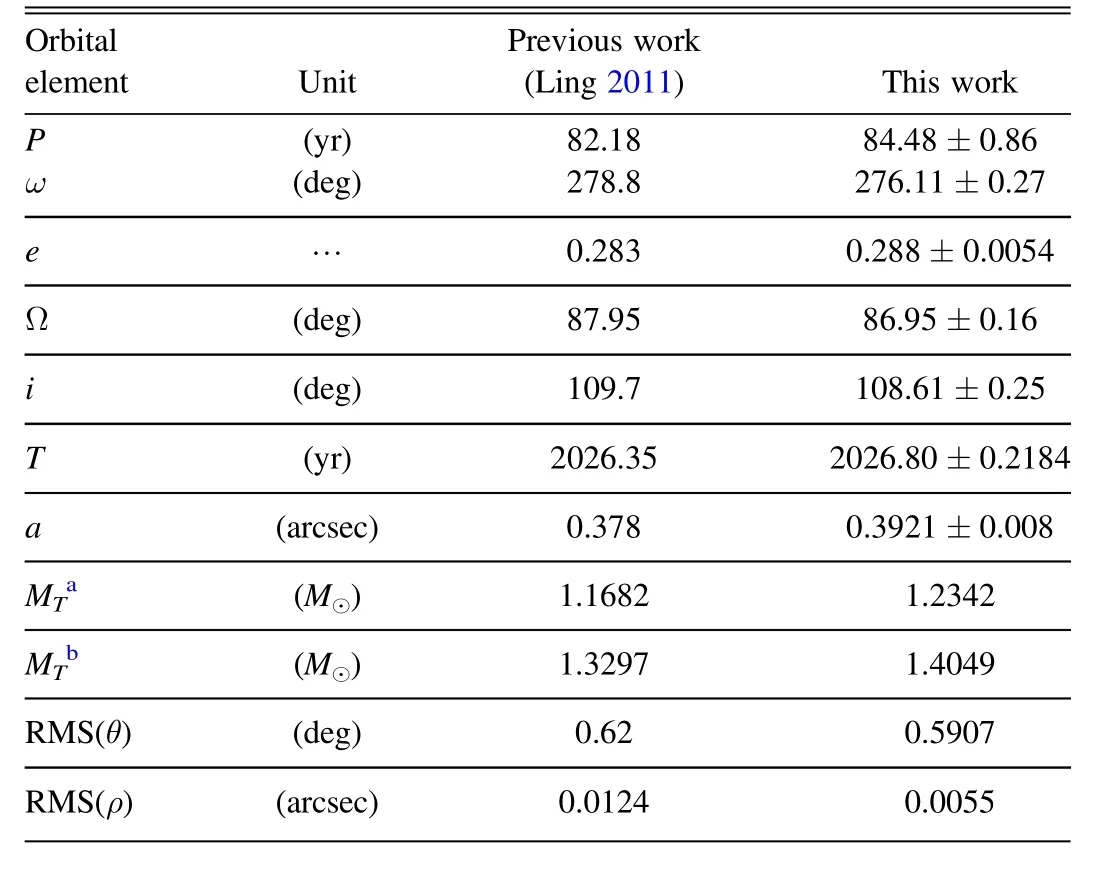
Table 4Orbital Parameter Solutions and Total Masses Formerly Published for the HIP 11253 System,for Comparison with this Work

Figure 1.The relative orbit of the binary system HIP 11253 constructed using the relative position.The measurements were taken from the Fourth Catalog of Interferometric Measurements of Binary Stars.
Table 4 shows a good agreement between our estimated orbital period(P);inclination(i);semimajor axis(a);eccentricity(e);position angle of nodes(Ω);argument of periastron(ω);and time of primary minimum(T)with previously reported results.
Figure 2 depicts the new orbit in comparison to the old one obtained earlier by Ling (2011).We estimated the total dynamical mass for this binary system using Kepler's third law.The total dynamical mass is given by

Figure 2.The difference in the orbit between the previous work (Ling 2011)and this work.

Figure 3.The entire (sum of the fluxes of members A and B) synthetic SED of the system HIP 11253 (built using parameters of the primary component,Teff=6025 K,log g=4.55 cm s-2,R=1.125R⊙and the computed flux of the secondary component with Teff=4710 K,log g=4.6055 cm s-2,R=0.88 R⊙ and d=54.99 pc) against the observational one;the figure also shows the synthetic SED for each component.

Figure 4.The entire synthetic SED of the system HIP 11253(built using parameters of the primary component,Teff=6025 K,log g=4.55 cm s-2,R=1.175R⊙and the com puted flux of the secondary component withTeff=4710 K,log g=4.60 cm s-2,R=092 R⊙ and d=52.67 pc)against the observational one;the figure also shows the synthetic SED for eac h component.
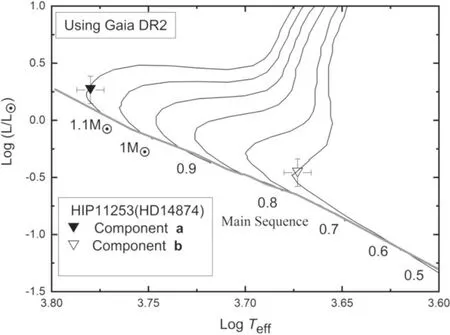
Figure 5.The evolutionary tracks of both components of HIP 11253 on the H-R diagram of masses using Gaia DR2 parallax.The evolutionary tracks were taken from Girardi et al.(2000).
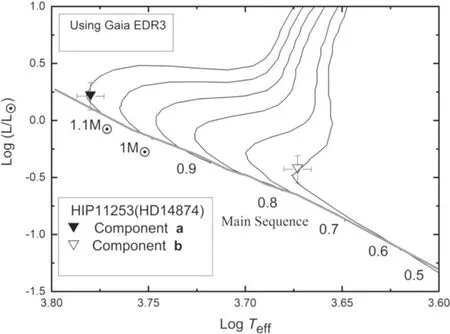
Figure 6.The evolutionary tracks of both components of HIP 11253 on the H-R diagram using Gaia EDR3 parallax.The evolutionary tracks were taken from Girardi et al.(2000).
whereais the semimajor axis in arcsec,π is the trigonometric parallax in arcsec,MA,MBare the masses of the individual components,Mdynis the dynamical mass sum,Pis the relative orbital period andM⊙is the mass of the Sun equal to 1.9891×1030kg.The error of the dynamical mass sum is given by
Using the orbital period and semimajor axis obtained from the orbital solution and parallax measurement,we estimate the dynamical mass as it appears in Table 4.
3.Atmospheric Modeling
3.1.Input Parameters
We derive the physical parameters of each component of the binary star system HIP 11253 by following Al-Wardat's method for analyzing BMSSs (Al-Wardat 2002).This is done by creating individual SED models for each system component using the visual magnitudefrom Table 1,and the average value for visual magnitude band16 from the speckle interferometric results in Table 2,along with parallax of the system (π=18.9878,d=52.67 pc) from Gaia DR2,(π=18.1854,d=54.99 pc) from Gaia EDR3 and the bolometric corrections (BCs)by Lang(1992).The preliminary specific value of the component input parameters are estimated as expressed in Table 5.To determine the apparent visual magnitude of individual componentswe use the following equations:

Table 5Preliminary Physical and Geometrical Properties of HIP 11253
HereAvis the interstellar extinction coefficient,and π the trigonometric parallax (Brown et al.2018).The absolute magnitude of individual componentscan be calculated according to the equations in Lang(1992)and Gray(2005).With the absolute magnitude,the effective temperature(Teff) and the BC can be obtained.The absolute bolometric magnitude(Mbol)is then calculated using BC.
The radius (R) is obtained through
The gravitational acceleration (logg)is obtained as
Note that theTeffand logg values for both components are considered as the preliminary input parameters for both components’ atmospheric modeling.As a result,we can compute their synthetic spectra.
3.2.Synthetic Spectra
The input parameters obtained in Section 3.1 are adopted to model the single star's atmosphere by using the corresponding model(ATLAS9)due to Kurucz(1994),while the entire SEDs were built using special subroutines of Al-Wardat's method.Another subroutine of the same method was also used to calculate the individual and entire SEDs.The following equation is used to calculate the synthetic SED as observed from the Earth,which is related to the energy flux of each component(Al-Wardat 2002)
which can be expressed as
Several works applied an iterative scheme using a different combination of input parameters to get the best fit between the observed flux and the total computed flux(see,i.e.,Al-Wardat&Widyan 2009).Additionally,multiple values of Δm,mvand parallax were applied to achieve convergence.In this way,various models were obtained and compared with the observedSED.The results are presented in Figures 3 and 4 and in Table 6.

Table 6The Final Results of These Individual Components and the Entire SEDs of the System HIP 11253
The criteria for Al-Wardat's method to find the best fit are based on the following:the inclination of the spectra,maximum values of the fluxes and profiles of the absorption lines.As a consequence,the best fit we have found (see Figures 3 and 4)used the following set of parameters (see Table 6).
However,Table 7 shows the synthetic spectrum for the entire and individual components of HIP 11253.The comparison between the observational and synthetic values for the color index and magnitude differences is listed in Table 8.A good indication of the reliability of the obtained parameters for the different system components is listed in Table 9.In addition,based on the ultimate effective temperatures of the system,we estimate the bolometric magnitudes and stellar luminosities by using the following equations
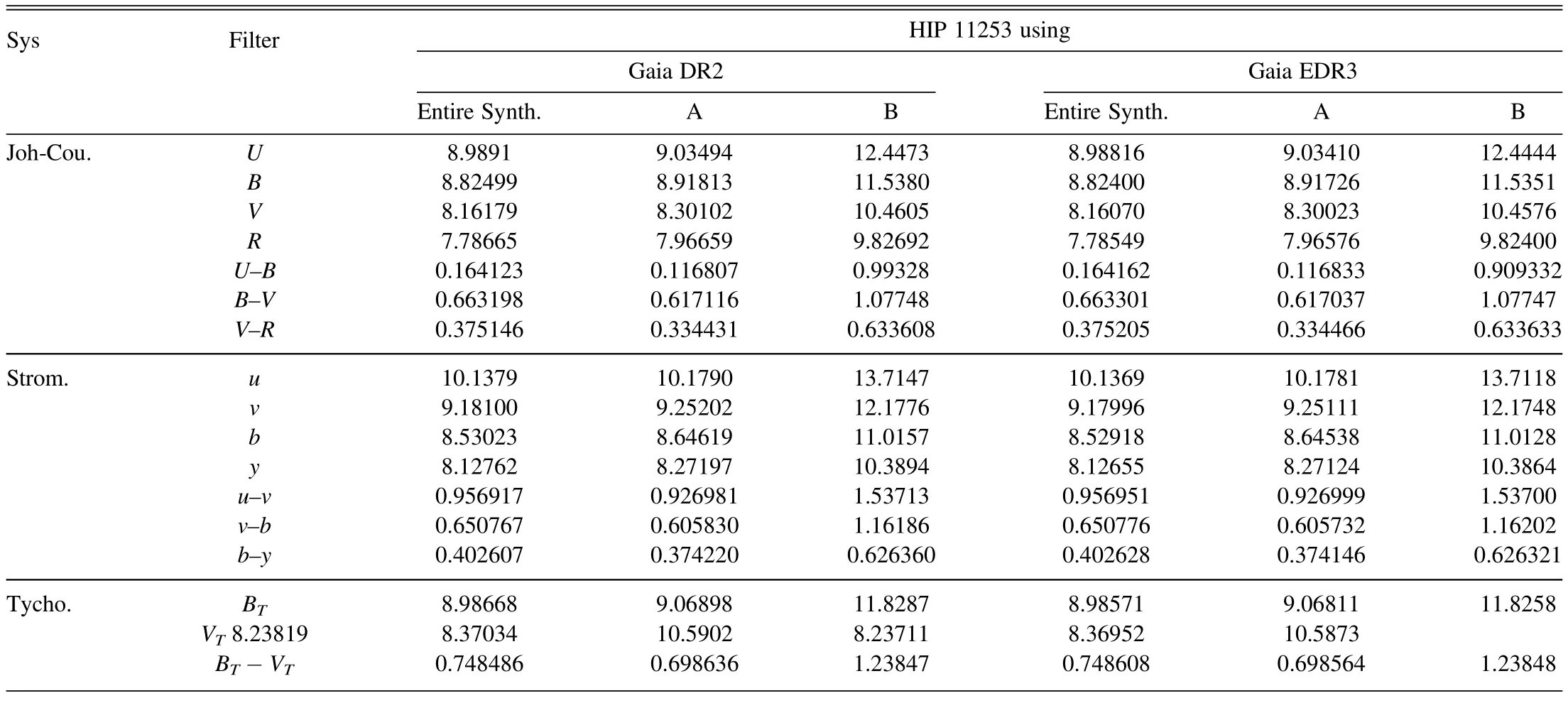
Table 7Magnitudes and Color Indices of the Entire Synthetic Spectrum and Individual Components of HIP 11253

Table 8Comparison Between the Observational and Synthetic Magnitudes and Color Indices for Both Systems.

Table 9Estimated Physical Parameters of Individual Components for HIP 11253 System Based on Two Parallax Measurements
The best fit values are sufficiently representative of the system component parameters.Using Lang (1992) and Gray (2005) empirical relations of spectral types and effective temperature,the spectral types of HIP 11253 components can be obtained as F9 and K3 for components a and b respectively.
4.Synthetic Photometry
Following the treatment by Al-Wardat (2002),the synthetic magnitudes are calculated from the synthetic SED using the following relationship
wherempis the synthetic magnitude of the passbandp,Pp(λ)is the dimensionless sensitivity function of the passbandp,Fλ.s(λ)is the synthetic SED of the object,Fλ.r(λ) is the SED of reference star Vega and ZPpthe zero-point taken from Maíz Apellániz (2007).By using the iteration method with different sets of observed stellar parameters like magnitude differences of the components,color indices of the entire system and individual components in (U-B-V-R) Johnson-Cousins,(uvby)Strömgren and(B-V)Tycho,one can get the best fit between the observational and synthetic magnitudes.This would help us to judge the accuracy of the estimated parameters using a special subroutine of Al-Wardat's method with the Interactive Data Language (IDL) platform and verify the estimated parameter reliability.As we can see,Figures 3 and 4 show best-fittings between the individual components and entire synthetic and observational SED.While on the other hand,Figures 5 and 6 display the evolutionary tracks of a theoretical Hertzsprung-Russell (H-R) diagram of both the components of HIP 11253,which are evolving off the main sequence.This helps to estimate the masses and spectral types as in Table 9.Al-Wardat's method for analyzing BMSSs gives a mass sum of 1.68M⊙for Gaia DR2 parallax and 1.71M⊙for Gaia EDR3 parallax.It is worth noting that masses estimated using this method along with the modified orbital elements are independent of the parallax values.From the comparison of dynamical masses using this approach,we realize that parallax measurement from EDR3 provides a good indication of the mass sum,due to the advance and higher resolution.
5.Conclusions
In this work,we have investigated the basic stellar parameters of the close visual binary system HIP 11253(HD 14874).Our investigation was based on the following considerations:
(a) Creating individual SED models for each system component as described in Section 3.1 using Al-Wardat's method for analyzing BMSSs (Al-Wardat 2002),combined with the parallax measurements by Gaia (DR2 and EDR3).
(b) The orbital elements were calculated following the dynamical method used by Tokovinin (1992).
(c) We used Al-Wardat's method to calculate the synthetic magnitude,where the results are displayed in Figures 3 and 4.
(d)The spectral types of both components are identified as F9 and K3,for components A and B respectively.
Acknowledgments
The authors used the codes of Al-Wardat's method for analyzing binary and multiple stellar systems.
The authors also thank Mounib Eid for providing his comments and suggestions.The authors would also like to thank the anonymous referee for the careful reading of the manuscript and for all suggestions and comments which allowed us to improve both the quality and the clarity of the paper.This work used the SAO/NASA database,Gaia Data Gaia (DR2 and EDR3),the SIMBAD database,the Fourth Catalog of Interferometric Measurements of Binary Stars and IPAC data systems.
ORCID iDs
杂志排行
Research in Astronomy and Astrophysics的其它文章
- Unveiling the Initial Conditions of Open Star Cluster Formation
- The Spin Measurement of MAXI J0637-430: a Black Hole Candidate with High Disk Density
- The Chromatic Point-spread Function of Weak Lensing Measurement in the Chinese Space Station Survey Telescope
- Evaluation of Coronal and Interplanetary Magnetic Field Extrapolation Using PSP Solar Wind Observation
- Sodium Abundances in Very Metal-poor Stars
- Asteroseismology of 16 Kepler Solar-like Stars: Stellar Parameters and the Effects of Element Diffusion
